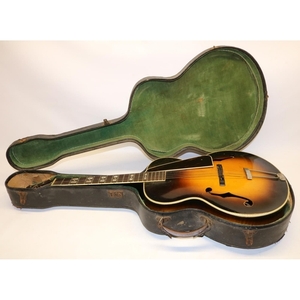News
Object In Focus: Gibson FDH - A Journey Through Land and Time
Posted On: 13 Nov 2023 by Jodie Merritt to Object In FocusGibson is a name that is instantly recognisable to any guitar fan - but where does the brand come from, and why are FDH models so valued? Read on for all you need to know as we dive into the history of Gibson guitars for this weeks Object In Focus.

Gibson FDH: A Journey Through Land and Time
Music is an essential element of life; it is the backdrop to our most crucial moments, a mood-lifter on a tricky day, or the perfect language when we simply cannot find the words to speak. Musical instruments are, of course, a crucial aspect of this, and often come with their own history and heritage which adds to the stories of the music they finally make.
Here at Ryedale Auctioneers, we were fortunate enough to come across such a story, when an incredible Gibson FDH crossed our path. We took a deeper dive into the story behind this incredible piece, and the insights that it can offer into history, and the people behind the stories.

Who Are Gibson?
Gibson is a brand with an amazing reputation, and boast a standing as one of the oldest manufacturers of musical instruments, having started in the USA back in 1894. It all started with a man named Orville Gibson -t he namesake of the famous brand - who started the project to fill a love of handcrafting musical instruments. Located in Kalamazoo, Michigan,
Gibson created an innovative guitar design which included a carved, hollow top, and an oval soundhold - this was the base for the archtop guitar. The invention was a huge success, and 1902 saw him take things to the next level with the creation of the Gibson-Mandolin Guitar Manufacturing Company. Sadly, Gibson died in 1918, without the chance to see the legend that his creation would become. The legacy, however, lived on.
The 1920’s saw an explosion in the world of guitar innovation, and Gibson lead the charge in the creation of the adjustable truss rod, and height adjustable bridge - both features which can be seen on Gibsons today. 1935 meant the first appearance of an electric guitar in the form of the EH-150 - a pale imitation of modern designs - and this was followed by the ES-150 a year later. Despite success here, Gibson continued with a primary focus on acoustic instruments with a quality sound, introducing popular models such as the Super Jumbo J-200 “King of the Flat Tops”, the J-45, and the Southern Jumbo - all of which are still played and enjoyed today. The introduction of the iconic cutaway allowed improved access to the upper frets, paving the ways for jazz and blues, and this is a trend that transformed guitar playing.

WWII and Beyond
The end of WWII saw the purchase of Gibson by the Chicago Musical Instrument Company, and the next few decades saw an incredible boom for the Gibson brand, seeing the creation of some iconic names and instruments, with the introduction of Ted McCarty and the invention of names such as the P-90 pickup, the ES-175 and the ES-5. The 1952 pairing with jazz guitarist and recorder Les Paul saw the creation of the signature Gibson Les Paul, and the 1957 acquisition of the Epiphone brand saw Gibson take charge of one of their biggest rivals.
The period between 1958 and 1960 is often considered Gibson’s “Golden Era”, with innovations such as the semi-hollow guitar, the Les Paul Standard, perhaps the single most popular electric guitar model in music history, and a model still revered to this day.
The Present Day
Gibson’s history post 1960 has been generally positive, with a few dips and dark spots that the brand have overcome - including a recent filing for Chapter 11 bankruptcy in 2018. A rescue by hedge fund KKR was successful, and the brand continue to build back under the watchful eye of JC Curleigh, a man who cut his teeth on Levi.
The Gibson FDH
The Gibson "FDH" archtops were manufactured by Gibson for export to the UK, specifically for Francis, Day, and Hunter, a music and instrument supplier based in London, England. This is why they are named as such. A total of 123 guitars were produced between 1937 and 1941, but only 115 were actually shipped. The remaining guitars were not sent due to the outbreak of war.
Here ar Ryedale, we werre lucky enough to get to work with one of these incredible models, which comes with the distinctive Gibson logo, as well as fretboard inlays and a number of other tell-tale hallmark signs of a Gibson, including the trapezoidal tailpiece, wooden floating bridge, open tuners, tortoiseshell effect pickguard and black and white checked binding around the top of the guitar. The back of the headstock is stamped "MADE IN THE U.S.A” - a nod to the lengthy journey the guitar has taken.
This piece was purchased in 1937 via an advert - a period which saw an embargo on any exportation from America. The guitar therefore took a journey through Canada, and into Britain, where it played in pride of place at the Lincolnshire Regiment Band and the Royal Artillery Band during WWII. The onset of D-Day saw the guitar posted safely home via the railway - in a departure from modern practices, the precious instrument was sent in just a case, with the address clearly written - a far cry from the couriers and signed confirmations required to transport such a guitar today!
Here at Ryedale, we are always honoured to handle a host of collectables, antiques, treasured and peculiarities - and working with this incredible Gibson has been a truly rock n roll experience! Make sure you head down to Ryedale Auctioneers for the sale - and see if you can land the winning bid!

